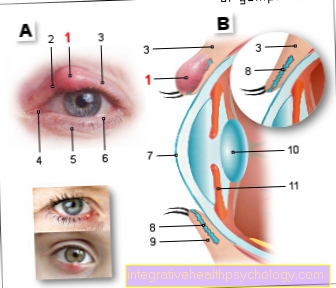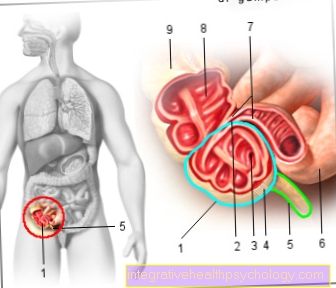Liver cirrhosis symptoms
The typical symptoms of cirrhosis of the liver
The symptoms of cirrhosis of the liver are as varied as the functions of the liver.
In general, one can say that two main functions of the liver are impaired by cirrhosis of the liver. On the one hand the liver synthesis capacity and on the other hand the metabolism and detoxification functions. The so-called leading symptom of severe liver diseases, especially liver cirrhosis, is jaundice (jaundice).
Jaundice occurs when there is a backlog of bile in the narrowed bile ducts and this is deposited in the skin via the blood vessels.
As a result, the skin and especially the eyes turn yellow. This jam can also be caused by gallstones.
As mentioned above, liver synthesis is clearly restricted by liver cirrhosis. This means that in particular the blood protein albumin and the coagulation factors are no longer sufficiently formed. Consequently, due to the reduced albumin, the proportion of fluid in the vessels decreases and instead escapes into the subcutaneous tissue. The classic phenomenon of ascites (abdominal fluid) occurs.
In addition, there are coagulation disorders, which greatly increases the bleeding tendency. The number of blood platelets also drops significantly and increases the tendency to bleed. At first, cirrhosis of the liver can manifest itself through symptoms such as tiredness, loss of appetite, poor performance and impotence.
Further symptoms are baldness, the lacquer tongue, a strong reddening of the palms (Palmar erythema), the Caput Medusae (Varices of the abdominal wall) and hepatic encephalopathy. The hepatic encephalopathy is mainly the cause of a defective detoxification function.
The liver cannot eliminate the toxins that arise. These can then get into the brain and cause considerable damage here. Due to the reduced detoxification function, drugs are also broken down more slowly and therefore have a longer effect. This point must be taken into account in drug treatment.
Read more on the subject below: The typical liver skin signs.
Diagnosis of cirrhosis of the liver

The diagnosis of cirrhosis of the liver is first made on the basis of the patient's medical history and clinical examination. Here the doctor would then notice certain symptoms that would point to cirrhosis as a suspected diagnosis.
Imaging and medical laboratory examinations are then initiated to confirm the suspected diagnosis. Sonography is one of the most important, cheapest and, above all, fastest imaging procedures. Here, not only the size of the liver, but also the quality of the tissue and the liver vessels can be assessed. In addition, the involvement of other abdominal organs, such as the spleen, can also be assessed. With severe cirrhosis of the liver, the spleen is often enlarged. A computed tomogram (CT) can also secure the diagnosis with high precision.
In laboratory medicine, the extent of liver cirrhosis can be clearly shown using the specific liver enzymes. These are greatly increased with necrotic changes in the liver. The most important enzymes in the liver include ALT (GOT), AST (GPT) and gamma GT.
Depending on the elevation pattern, it is possible to differentiate which type of liver disease it is. The most direct examination method is the sonography-guided liver biopsy. Here the doctor can assess directly under the microscope to what extent the liver tissue has changed or how far the liver cirrhosis has progressed. It is even more important to assess whether precursors of liver cancer have developed from cirrhosis.
























.jpg)



